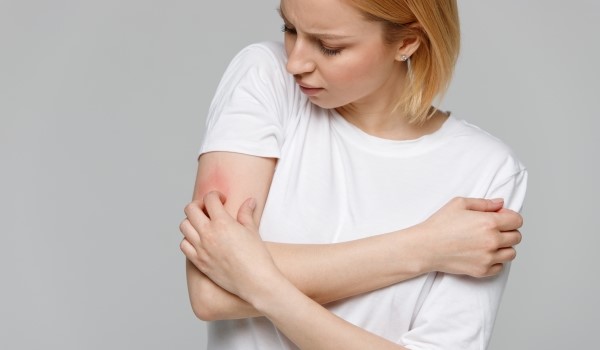What exactly is a
Cold allergy?
Cold allergy, also known as cold urticaria, is a rare form of physical urticaria. This is an allergic reaction of the skin to exposure to cold. People with cold urticaria develop itchy, red wheals or swellings on the skin when exposed to cold. The reaction typically occurs within a few minutes of exposure to cold and can vary from mild itching to severe pain.
As cold urticaria can be life-threatening, sufferers should maintain close contact with a dermatologist or allergist in order to develop suitable treatment and prevention strategies.
About the symptoms
More information
Important facts about cold allergy
What kind of cold triggers cold urticaria?
Triggers can be cold air in cold environments, contact with cold water, e.g. when washing your hands or showering, or cold objects. The consumption of cool drinks or food can also lead to allergic reactions if they come into contact with the mouth, lips or throat. The temperature of the triggering cold sources can vary individually and is different for each person affected. As a rule, however, the reaction occurs at temperatures below body temperature, but more frequently at less than 20 degrees.
Life-threatening cold stimuli:
With sudden and very strong cold exposures, such as a jump into cold water, the reaction can occur on the entire body surface, leading to a systemic reaction. In severe cases, this can trigger an anaphylactic reaction, which can lead to breathing difficulties, cardiovascular problems, a drop in blood pressure and loss of consciousness and thus represents a life-threatening emergency situation.
How is a cold allergy diagnosed?
The diagnosis of cold urticaria is usually based on a thorough medical history, physical examination and special cold tests. It is important that the diagnosis is made by a dermatologist or allergist, as these specialists specialize in skin diseases and allergic reactions.
It is important that appropriate safety precautions are taken during the cold tests to avoid possible severe allergic reactions. Therefore, these tests should only be performed by trained medical personnel in a controlled environment.
What preventive measures can be taken?
Avoiding exposure to cold
Direct exposure to cold should be avoided by wearing warm clothing, especially in cold environments or in contact with cold water or objects. Air-conditioned rooms with a moderate temperature should be preferred to avoid excessive cold.
Drug treatment
Drug treatment can also be helpful. Antihistamines can reduce allergic symptoms such as itching and redness, but they should always be taken under medical supervision. People with an increased risk of anaphylactic reactions can carry an emergency medication with them in consultation with their doctor.
Stress management and information
As with many other diseases, it is important to avoid stress, as strong emotions can exacerbate symptoms. Wearing a bracelet or necklace with information about cold urticaria and possible allergies enables medical professionals to be informed and to react appropriately in an emergency.
Sources
Please note that all content provided regarding individual medical conditions, treatments, procedures, etc. is general information and may vary depending on the physician:in and individual case and initial situation.
For more detailed information, please always consult your doctor.
Guideline: Classification, diagnosis and treatment of urticaria
www.awmf.orgAltmeyers Encyclopedia: Urticaria
www.altmeyers.org